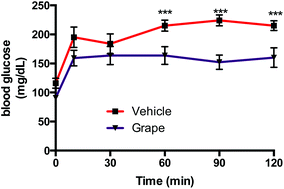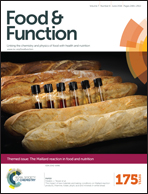Grape powder attenuates the negative effects of GLP-1 receptor antagonism by exendin-3 (9–39) in a normoglycemic mouse model†
Abstract
Prediabetes is a condition affecting 35% of US adults and about 50% of US adults age 65+. Foods rich in polyphenols, including flavanols and other flavonoids, have been studied for their putative beneficial effects on many different health conditions including type 2 diabetes mellitus and prediabetes. Studies have shown that some flavanols increase glucagon-like peptide 1 (GLP-1) secretion. GLP-1 is a feeding hormone that increases insulin secretion after carbohydrate consumption, and increased GLP-1 secretion may be responsible for some of the beneficial effects on glycemic control after flavanol consumption. The present study explored the effects of grape powder consumption on metrics of glycemic health in normoglycemic and prediabetic C57BL/6J mice; additionally, the mechanism of action of grape powder polyphenols was investigated. Grape powder significantly reduced (p < 0.01) blood glucose levels following oral glucose gavage after GLP-1 receptor antagonism by exendin-3 (9–39) compared to sugar-matched control, indicating that it was able to attenuate the hyperglycemic effects of GLP-1 receptor antagonism. Grape powder was employed in acute (1.6 g grape powder per kg bodyweight) and long-term high fat diet (grape powder incorporated into treatment diets at 5% w/w) feeding studies in normoglycemic and prediabetic (diet-induced obesity) mice; grape powder did not impove glycemic control in these studies versus sugar-matched control. The mechanisms by which grape powder ameliorates the deleterious effects of GLP-1 receptor antagonism warrant further study.


 Please wait while we load your content...
Please wait while we load your content...